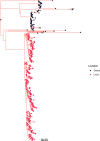Dissemination of Pseudomonas aeruginosa blaNDM-1-Positive ST308 Clone in Singapore
- PMID: 37042789
- PMCID: PMC10269627
- DOI: 10.1128/spectrum.04033-22
Dissemination of Pseudomonas aeruginosa blaNDM-1-Positive ST308 Clone in Singapore
Abstract
Pseudomonas aeruginosa ST308 clone has been reported to carry carbapenemase genes such as blaIMP and blaVIM but has been rarely associated with blaNDM-1. A total of 199 P. aeruginosa ST308 clinical and environmental isolates obtained between April 2019 and November 2020 from a tertiary-care hospital in Singapore were characterized using whole-genome sequencing. In addition, 71 blaNDM-1-positive ST308 whole-genome sequences from two other local tertiary-care hospitals in Singapore and 83 global blaNDM-1-negative ST308 whole-genome sequences in public databases were included to assess phylogenetic relationships and perform genome analyses. Phylogenetic analysis and divergent time estimation revealed that blaNDM-1-positive P. aeruginosa ST308 was introduced into Singapore in 2005 (95 % highest posterior density: 2001 to 2008). Core genome, resistome, and analyses of all local blaNDM-1-positive ST308 isolates showed chromosomal integration of multiple antibiotic resistance genes (ARGs) [aac(3)-Id, aac(6')-Il, aadA6, aadA11, dfrB5, msr(E), floR, sul2, and qnrVC1], which was absent in global blaNDM-1-negative ST308 sequences. Most ARGs and virulence genes were conserved across isolates originating from the three different local hospitals. Close genetic relatedness of the blaNDM-1-positive ST308 clinical and environmental isolates suggests cocirculation between the hospital environment and human hosts with the hospital environment as a potential reservoir. Core genome single nucleotide polymorphism analyses revealed possible clonal transmission of blaNDM-1-positive ST308 isolates between the three hospitals over 7 years. Bloodstream isolates accounted for six of 95 (6.3%) clinical isolates. This study reports the introduction of a pathogenic blaNDM-1-positive P. aeruginosa ST308 more than a decade ago in Singapore and warrants surveillance for wider dissemination. IMPORTANCE P. aeruginosa is a Gram-negative opportunistic pathogen ubiquitously found in the environment and a major cause of nosocomial infections. While the P. aeruginosa ST308 clone has been known to bear blaIMP and blaVIM among global isolates, reports of blaNDM-1-positive P. aeruginosa ST308 are rare. The local blaNDM-1-positive P. aeruginosa ST308 isolates detected in this study appear to be unique to this region, with evidence of chromosomal acquisition of multiple ARGs compared to global blaNDM-1-negative P. aeruginosa ST308 isolates. Surveillance in Singapore and beyond for dissemination is essential to determine whether existing measures are sufficient to control the spread of this ST308 clone.
Keywords: Pseudomonas aeruginosa; ST308; carbapenemase; chromosomal integration; region-specific; whole-genome sequencing.
Conflict of interest statement
The authors declare no conflict of interest.
Figures




Similar articles
-
First Detection and Molecular Characterization of Pseudomonas aeruginosa blaNDM-1 ST308 in Greece.Microorganisms. 2023 Aug 26;11(9):2159. doi: 10.3390/microorganisms11092159. Microorganisms. 2023. PMID: 37764003 Free PMC article.
-
Development of antibiotic resistance in the ocular Pseudomonas aeruginosa clone ST308 over twenty years.Exp Eye Res. 2021 Apr;205:108504. doi: 10.1016/j.exer.2021.108504. Epub 2021 Feb 18. Exp Eye Res. 2021. PMID: 33610601
-
Genomic epidemiology and molecular characteristics of blaNDM-1-positive carbapenem-resistant Pseudomonas aeruginosa belonging to international high-risk clone ST773 in the Gauteng region, South Africa.Eur J Clin Microbiol Infect Dis. 2024 Apr;43(4):627-640. doi: 10.1007/s10096-024-04763-5. Epub 2024 Jan 24. Eur J Clin Microbiol Infect Dis. 2024. PMID: 38265603 Free PMC article.
-
Fatal respiratory infection due to ST308 VIM-1-producing Pseudomonas aeruginosa in a lung transplant recipient: case report and review of the literature.BMC Infect Dis. 2020 Aug 26;20(1):635. doi: 10.1186/s12879-020-05338-3. BMC Infect Dis. 2020. PMID: 32847524 Free PMC article. Review.
-
Pseudomonas aeruginosa epidemic high-risk clones and their association with horizontally-acquired β-lactamases: 2020 update.Int J Antimicrob Agents. 2020 Dec;56(6):106196. doi: 10.1016/j.ijantimicag.2020.106196. Epub 2020 Oct 9. Int J Antimicrob Agents. 2020. PMID: 33045347 Review.
Cited by
-
The genomic configurations driving antimicrobial resistance and virulence in colistin resistant Pseudomonas aeruginosa from an Egyptian Tertiary Oncology Hospital.PLOS Glob Public Health. 2025 Aug 5;5(8):e0004976. doi: 10.1371/journal.pgph.0004976. eCollection 2025. PLOS Glob Public Health. 2025. PMID: 40763289 Free PMC article.
-
Emergence of NDM-1-Producing Pseudomonas aeruginosa Nosocomial Isolates in Attica Region of Greece.Microorganisms. 2024 Aug 23;12(9):1753. doi: 10.3390/microorganisms12091753. Microorganisms. 2024. PMID: 39338428 Free PMC article.
-
Prioritization of Critical Factors for Surveillance of the Dissemination of Antibiotic Resistance in Pseudomonas aeruginosa: A Systematic Review.Int J Mol Sci. 2023 Oct 15;24(20):15209. doi: 10.3390/ijms242015209. Int J Mol Sci. 2023. PMID: 37894890 Free PMC article.
-
First Detection and Molecular Characterization of Pseudomonas aeruginosa blaNDM-1 ST308 in Greece.Microorganisms. 2023 Aug 26;11(9):2159. doi: 10.3390/microorganisms11092159. Microorganisms. 2023. PMID: 37764003 Free PMC article.
References
-
- Hidron AI, Edwards JR, Patel J, Horan TC, Sievert DM, Pollock DA, Fridkin SK, National Healthcare Safety Network Team and Participating National Healthcare Safety Network Facilities . 2008. Antimicrobial-resistant pathogens associated with healthcare-associated infections: annual summary of data reported to the National Healthcare Safety Network at the Centers for Disease Control and Prevention, 2011–2014. Infect Control Hosp Epidemiol 29:996–1011. doi:10.1086/591861. - DOI - PubMed
-
- Jones S, Holmes FA, O’Shaughnessy J, Blum JL, Vukelja SJ, McIntyre KJ, Pippen JE, Bordelon JH, Kirby RL, Sandbach J, Hyman WJ, Richards DA, Mennel RG, Boehm KA, Meyer WG, Asmar L, Mackey D, Riedel S, Muss H, Savin MA. 2009. Docetaxel with cyclophosphamide is associated with an overall survival benefit compared with doxorubicin and cyclophosphamide: 7-year follow-up of US. J Clin Oncol 27:1177–1183. doi:10.1200/JCO.2008.18.4028. - DOI - PubMed
-
- Zhanel GG, DeCorby M, Adam H, Mulvey MR, McCracken M, Lagacé-Wiens P, Nichol KA, Wierzbowski A, Baudry PJ, Tailor F, Karlowsky JA, Walkty A, Schweizer F, Johnson J, Hoban DJ, Canadian Antimicrobial Resistance Alliance . 2010. Prevalence of antimicrobial-resistant pathogens in Canadian hospitals: results of the Canadian Ward Surveillance Study (CANWARD 2008). Antimicrob Agents Chemother 54:4684–4693. doi:10.1128/AAC.00469-10. - DOI - PMC - PubMed
Publication types
MeSH terms
Substances
LinkOut - more resources
Full Text Sources
Miscellaneous

